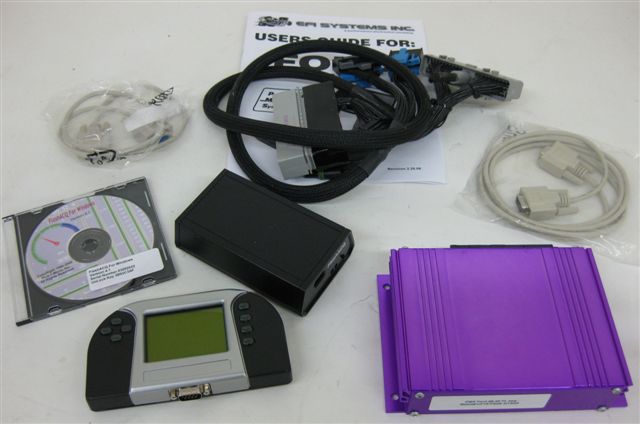PMS Tuning Tips
The below information will help guide you in the right direction if you are running a PMS system. Direct support is no longer available. There is no staff available that has the knowledge of this system.
Series IV ECC-IV PMS tuning tips
 No matter how old or new your Mustang's ECU is, adding a PMS can help you get the most out of your performance modifications. Here's what you need to know about how a PMS works and the basics of tuning one.
No matter how old or new your Mustang's ECU is, adding a PMS can help you get the most out of your performance modifications. Here's what you need to know about how a PMS works and the basics of tuning one.
To start off with lets set the throttle position sensor, so the PMS is on the right load tables. Warm the car up to operating temperature (180-198) do this with a drive. Don’t just let it sit and idle. Set your base idle (with the idle motor unplugged) at 850-900 rpm with the throttle screw.
Now shut the car off, turn key to on position and check your T.P. sensor voltage with a volt meter. Take that voltage ( lets say it is 1.04 volts) and go into the PMS option to TPS voltage and set idle voltage to 1.06. Now turn off key and turn it back on. It should say idle now on the data screen. If not readjust voltage numbers till it does. Next put throttle pedal to the floor and make sure PMS says WOT in data screen. If not adjust WOT T.P. sensor voltage until it does. This gets the PMS in sinc with the load table.
Stand Alone
With your base timing set at 10 degrees and the stand alone turned on with no changes in the PMS the total timing is 25 degrees at W.O.T. above the rpm and throttle position you chose to turn on the stand alone. Air fuel target is 12.8 to 1 at W.O.T. with a correctly calibrated Pro-M mass air meter in the stand alone tables.
Knowing this, it is easy to tune if you know how much timing you want. If you want 32 degrees at wide open throttle at 6000 rpm, you put +7 at WOT at 6000 rpm in the PMS and this will give you 32 degrees total at 6000 rpm.
Timing range for 5.0 Mustang
Natural Aspirated: pump gas 9.5 compression 29-32 degrees total advance at 6000 rpm.
Super Charged: pump gas 14 lb of boost 17-21 degrees total advance at 6000 rpm.
The trick to tuning the timing, is the curve not just the total advance. You have to experiment with and see what your combination likes. The same goes for the fuel curve.
Understanding the Boost Tables
Lets say your car has 14lb of boost at 6000 rpm If you have the boost table turned on in the PMS and have the max boost set at 20 lb. you have at MAX boost 6000 rpm -10. This will give you a total timing at 6000 rpm with 14 lb of boost 18 degrees.
How to calculate this out is, take the timing (-10) you have in max boost, divide it by the setting you have in for max boost which is 20, and multiply it by the cars max boost at 6000 rpm. So, it will look like this -10 divided by 20 times 14 = -7. That means the PMS will pull 7 degrees out of your base of 25. This will leave you with So you will have 18 degrees.
If you have timing put in at WOT . Lets say you have +4. That would be included with the boost timing so you would have 22 degrees at 6000 and 14lb of boost.
How Do I Get the Best Performance from a PMS?
A road tune will get you in the ballpark, but there's nothing like a tune in the controlled environment of a dyno. Even though AFM no longer supports this system, some tuning shops may still have knowledge about the system.
Does Anderson Ford Motorsport still offer e-mail tunes?
The PMS series of devices went obsolete in 2017 and are no longer supported by Anderson Ford Motorsport as of 2018. The above information will help you get started but e-mail tunes are no longer available for purchase directly from Anderson Ford Motorsport. If you have any further inquiries send an e-mail to hirev1@anderson-ford.com
